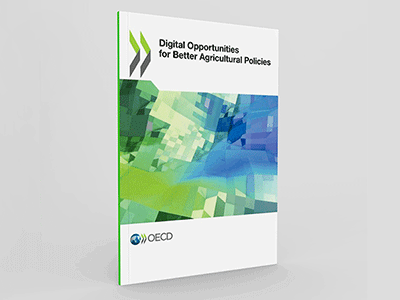Technology and digital in agriculture
New technologies and digitalisation are transforming agriculture and offering new opportunities to improve policy
The world’s first entirely machine-operated crop – a crop sown and tended without a human ever entering the field – was harvested in 2017, a milestone in digital agriculture, sometimes known as “smart farming”, or “e-agriculture”.
Digital technologies—including the Internet, mobile technologies and devices, data analytics, artificial intelligence, digitally-delivered services and apps—are changing agriculture and the food system. Examples abound at different stages of the agri-food value chain: farm machinery automation allows fine-tuning of inputs and reduces demand for manual labour; remote satellite data and in-situ sensors improve the accuracy and reduce the cost of monitoring crop growth and quality of land or water; and traceability technologies and digital logistics services offer the potential to streamline agri-food supply chains, while also providing trusted information for consumers.
Digital technologies can also help governments improve the efficiency and effectiveness of existing policies and programmes, and to design better ones. For instance, freely available and high-quality satellite imagery dramatically reduces the cost of monitoring many agricultural activities. This could allow governments to move towards more targeted policies which pay (or penalise) farmers based on observed environmental outcomes. In addition to monitoring compliance with environmental policies, digital technologies enable automation of administrative processes for agriculture and the development of expanded government services, such as in relation to extension or advisory services.
Finally, digital technologies can support trade in agriculture and food products, by connecting private sector suppliers to new markets, and enabling new ways for governments to monitor and ensure compliance with standards and to provide faster and more efficient border procedures that are essential for perishable products.
These technological advances can support the goal of achieving more resilient, productive, and sustainable agriculture and food systems, which better meet consumer needs. These benefits come both directly—via the adoption of technologies by actors in the sector (including service providers), and indirectly—via the adoption of technology by governments in order to deliver better policies.
What can governments do to reap the benefits of digital technologies for the agriculture sector?
Three key questions highlight the actions needed from governments to ensure the opportunities offered by digital technologies are realised:
- First, how can government policies and programmes appropriately facilitate the adoption of digital technologies by the agriculture and food sectors? Policymakers will need to consider potential benefits, costs and risks, and to understand the factors affecting technology uptake so that interventions can be targeted to where there is a market failure, or a public interest.
- How can governments make use of digital technologies to design and deliver better agricultural policies? This requires understanding how technology can help in different components of the policy cycle, and may require government bodies to expand their skillsets, invest in technology and training, or partner with other actors (both government and non-government).
- How might digital technologies change the roles of government? On the one hand, digital technologies may create new roles or responsibilities for governments, including to enable the digital infrastructure (is there a case for governments to be a provider or a rule maker of new digital infrastructure, and under what circumstances); but on the other hand, if technology can reduce information asymmetries and transactions costs, less government intervention may be needed.
For policymakers, the challenge will be to shape policy and regulatory settings so that they facilitate opportunities offered by digital technologies. At the same time, and not unique to the agriculture sector, digital technologies raise questions about privacy, interoperability, and even potential liability issues, all of which will need careful consideration.
Reaping the benefits of digital technologies in agriculture requires the participation and co-operation of farmers, researchers, private sector, non-profits and government
OECD work is examining the benefits and challenges of using technologies for policy in agriculture, with particular insights drawn from agri-environmental policies, and for agro-food trade. Further issues include how the regulatory environment can influence sustainable and inclusive uptake of digital technologies; how technologies might affect skills needs in the sector; and how tracebility technologies can improve agricultural value chain transparency, enhance food safety and combat fraud; and potentially enablee new demand-side policies to promote sustainability.
For more information on how digital technologies are impacting food growth and distribution, you can download presentations and background information from our 2018 Global Forum on Agriculture.
Latest update
Digital Opportunities for Better Agricultural Policies
Drawing on ten illustrative case studies and unique new data gathered via an OECD questionnaire on agri-environmental policy organisations' experiences with digital tools, this report explores opportunities to improve current agricultural and agri-environmental policies, and to deliver new, digitally enabled and information-rich policy approaches.
Policy brief
Digital agriculture publications
Access all OECD publications on technology and digital in agriculture on the OECD iLibrary.
Agriculture and fisheries publications
All of our food, agriculture and fisheries research and analysis is available to read online for free on the OECD iLibrary.
Sign up for our newsletter
Sign-up to our agriculture newsletter to receive periodic e-mail updates on new publications, videos and analysis.
Contact us with your questions
If you have questions about OECD research and analysis on agriculture, please feel free to contact us directly.
